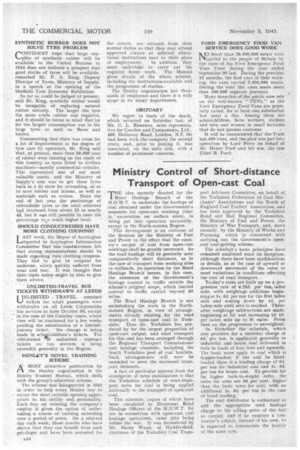Ministry Control of Short-distance Transport of Open-cast Coal
Page 18

If you've noticed an error in this article please click here to report it so we can fix it.
THE idea recently Mooted for the Road Haulage Branch of the M.O.W.T. to undertake the haulage of coal obtained under the Government's measures for open-cast working (that is, ' excavation on surface sites), is being put into operation nationally, except in the North-eastern Region.
This development is an outcome of the decision by the Ministry of Fuel and Power to the effect that the calm
try's output of Coal from open-cast workings shall be greatly increased. As the road haulage will be generally over comparatively short distances, as in the case of transport from working sites to railheads, its operation by the Road Haulage Branch means, in this ease, the extension of the Government's haulage control to traffic outside the scheme's original scope, which limited ..control to -traffic carried beyond 60 miles, The Road Haulage Branch is not undertaking the work in the Northeastern Region, in view of arrangements already existing for the road transport of open-cast coal in Yorkshire. Thus far, Yorkshire has produced by far the largest proportion of open-cast output, and road transport for this coal has been arranged through the Regional Transport Commissioner and haulage channels, including the South Yorkshire pool of coal hauliers. Such arrangements will now he extended to meet the increased trans-_ port demands.
A fact of particular interest from the standpoint of rates stabilization is that the Yorkshire schedule of road-transport rates for coal is being applied nationally to the transport of open-cast coal.
This schedule, copies of which have been circulated to Divisional Road Haulage Officers of the M.O.W.T, for use in. connettion with open-cast coal haulage operations, 'came into being before the war. It was formulated by Mr. Harry Wood, of Huddersfield, chairman of the Yorkshire Coal Trans
port Advisory Committee, on behalf of the Yorkshire Federation of Coal Merchants' Associations and the North of England Coal Traders' Association, and has been approved by the Yorkshire Road and Rail Regional Committee, the Ministry of Fuel and Power, the Ministry of War Transport, and, more recently, by the MinistryPf Works and Planning, which is concerned with carrying out the Government's opencast coal-getting scheme.
The _schedule's basic principles have remained unaltered since its inception, although therehave been modifications in details, as in the case of upward or downward movement of the rates to meet variations in conditions affecting the cost of road transport.
To-day's rates are built up on a progression rate of 4.25d.. ,per tone laden mile, with weightage additions beginning at Is. 3d. per ton for the first laden mile and scaling down by Id, per laden mile until zer6 is reached. Thereafter is.-eightage subtractions are made, beginning at Id. and increasing by Id. per laden mile up to 31 riles. From then on the progression is unweighted.
In. Yorkshire the schedule, which also provides for a terminal charge of fid.. per ton, is applicable generally to industrial and house coal delivered in bulk in loads of four tons and upwards. The basic rates apply to coal which is hopper-loaded; if the coal be handloaded there is a loading charge of .9d, per ton for industrial coal and. Is. 3d. per ton for house coal. To provide for its higher bulk-to-weight ratio, the rates for coke are 50 per cent. higher than the basic rates for coal, with an additional 1s. 9d. per tonin the case of hand loading..
The coal distributor is authorized to add the appropriate road haulage charge to his selling price of the fuel so carried, -and if he employs a 'contractor's vehicle, instead of his own, he is expected to remunerate the haulier at the same rate.




















































